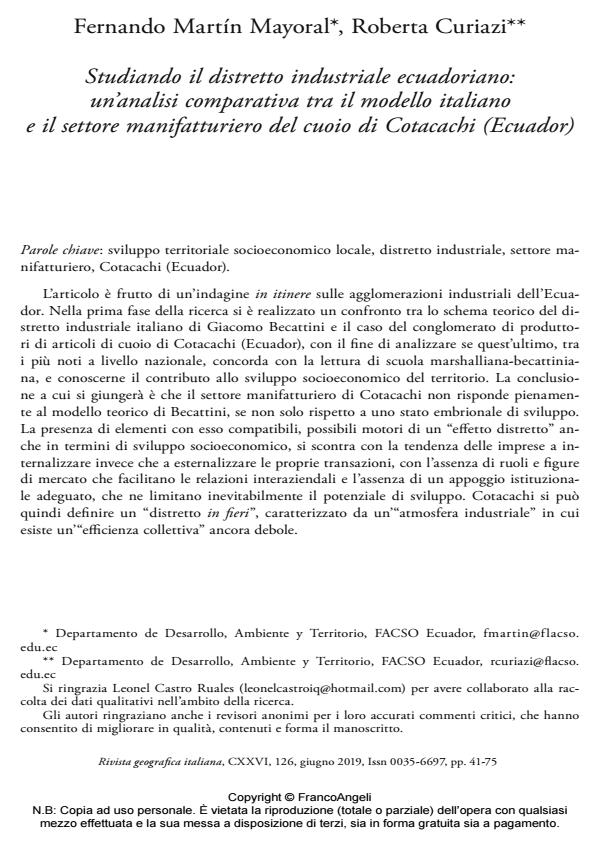Studiando il distretto industriale ecuadoriano: un’analisi comparativa tra il modello italiano e il settore manifatturiero del cuoio di Cotacachi (Ecuador)
Titolo Rivista RIVISTA GEOGRAFICA ITALIANA
Autori/Curatori Fernando Martín Mayoral, Roberta Curiazi
Anno di pubblicazione 2019 Fascicolo 2019/2
Lingua Italiano Numero pagine 35 P. 41-75 Dimensione file 296 KB
DOI 10.3280/RGI2019-002003
Il DOI è il codice a barre della proprietà intellettuale: per saperne di più
clicca qui
Qui sotto puoi vedere in anteprima la prima pagina di questo articolo.
Se questo articolo ti interessa, lo puoi acquistare (e scaricare in formato pdf) seguendo le facili indicazioni per acquistare il download credit. Acquista Download Credits per scaricare questo Articolo in formato PDF

FrancoAngeli è membro della Publishers International Linking Association, Inc (PILA)associazione indipendente e non profit per facilitare (attraverso i servizi tecnologici implementati da CrossRef.org) l’accesso degli studiosi ai contenuti digitali nelle pubblicazioni professionali e scientifiche
L’articolo è frutto di un’indagine in itinere sulle agglomerazioni industriali dell’Ecuador. Nella prima fase della ricerca si è realizzato un confronto tra lo schema teorico del distretto industriale italiano di Giacomo Becattini e il caso del conglomerato di produttori di articoli di cuoio di Cotacachi (Ecuador), con il fine di analizzare se quest’ultimo, tra i più noti a livello nazionale, concorda con la lettura di scuola marshalliana-becattiniana, e conoscerne il contributo allo sviluppo socioeconomico del territorio. La conclusione a cui si giungerà è che il settore manifatturiero di Cotacachi non risponde pienamente al modello teorico di Becattini, se non solo rispetto a uno stato embrionale di sviluppo. La presenza di elementi con esso compatibili, possibili motori di un "effetto distretto" anche in termini di sviluppo socioeconomico, si scontra con la tendenza delle imprese a internalizzare invece che a esternalizzare le proprie transazioni, con l’assenza di ruoli e figure di mercato che facilitano le relazioni interaziendali e l’assenza di un appoggio istituzionale adeguato, che ne limitano inevitabilmente il potenziale di sviluppo. Cotacachi si può quindi definire un "distretto in fieri", caratterizzato da un’"atmosfera industriale" in cui esiste un’"efficienza collettiva" ancora debole.
Parole chiave:Sviluppo territoriale socioeconomico locale, distretto industriale, settore manifatturiero, Cotacachi (Ecuador).
- Geopolitical Perspectives from the Italian Border Christian Sellar, Gianfranco Battisti, pp.3 (ISBN:978-3-031-26043-8)
Fernando Martín Mayoral, Roberta Curiazi, Studiando il distretto industriale ecuadoriano: un’analisi comparativa tra il modello italiano e il settore manifatturiero del cuoio di Cotacachi (Ecuador) in "RIVISTA GEOGRAFICA ITALIANA" 2/2019, pp 41-75, DOI: 10.3280/RGI2019-002003